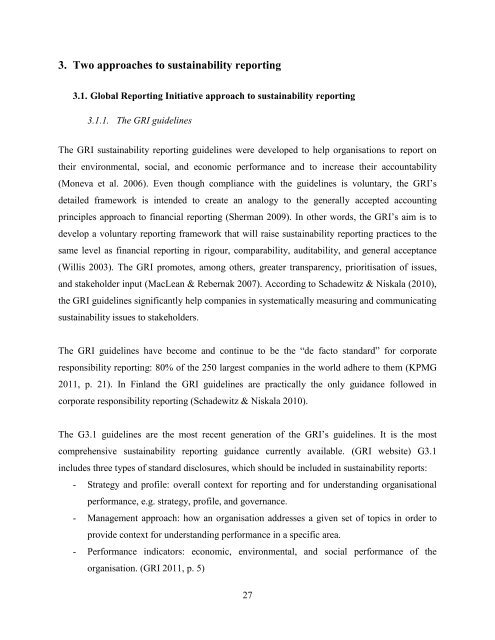Developing sustainability reporting - Case Cargotec - Aaltodoc
Developing sustainability reporting - Case Cargotec - Aaltodoc
Developing sustainability reporting - Case Cargotec - Aaltodoc
You also want an ePaper? Increase the reach of your titles
YUMPU automatically turns print PDFs into web optimized ePapers that Google loves.
3. Two approaches to <strong>sustainability</strong> <strong>reporting</strong><br />
3.1. Global Reporting Initiative approach to <strong>sustainability</strong> <strong>reporting</strong><br />
3.1.1. The GRI guidelines<br />
The GRI <strong>sustainability</strong> <strong>reporting</strong> guidelines were developed to help organisations to report on<br />
their environmental, social, and economic performance and to increase their accountability<br />
(Moneva et al. 2006). Even though compliance with the guidelines is voluntary, the GRI’s<br />
detailed framework is intended to create an analogy to the generally accepted accounting<br />
principles approach to financial <strong>reporting</strong> (Sherman 2009). In other words, the GRI’s aim is to<br />
develop a voluntary <strong>reporting</strong> framework that will raise <strong>sustainability</strong> <strong>reporting</strong> practices to the<br />
same level as financial <strong>reporting</strong> in rigour, comparability, auditability, and general acceptance<br />
(Willis 2003). The GRI promotes, among others, greater transparency, prioritisation of issues,<br />
and stakeholder input (MacLean & Rebernak 2007). According to Schadewitz & Niskala (2010),<br />
the GRI guidelines significantly help companies in systematically measuring and communicating<br />
<strong>sustainability</strong> issues to stakeholders.<br />
The GRI guidelines have become and continue to be the “de facto standard” for corporate<br />
responsibility <strong>reporting</strong>: 80% of the 250 largest companies in the world adhere to them (KPMG<br />
2011, p. 21). In Finland the GRI guidelines are practically the only guidance followed in<br />
corporate responsibility <strong>reporting</strong> (Schadewitz & Niskala 2010).<br />
The G3.1 guidelines are the most recent generation of the GRI’s guidelines. It is the most<br />
comprehensive <strong>sustainability</strong> <strong>reporting</strong> guidance currently available. (GRI website) G3.1<br />
includes three types of standard disclosures, which should be included in <strong>sustainability</strong> reports:<br />
- Strategy and profile: overall context for <strong>reporting</strong> and for understanding organisational<br />
performance, e.g. strategy, profile, and governance.<br />
- Management approach: how an organisation addresses a given set of topics in order to<br />
provide context for understanding performance in a specific area.<br />
- Performance indicators: economic, environmental, and social performance of the<br />
organisation. (GRI 2011, p. 5)<br />
27
















